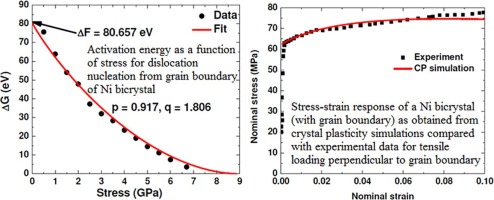当前位置:
X-MOL 学术
›
Comp. Mater. Sci.
›
论文详情
Our official English website, www.x-mol.net, welcomes your feedback! (Note: you will need to create a separate account there.)
Simulation of bicrystal deformation including grain boundary effects: Atomistic computations and crystal plasticity finite element analysis
Computational Materials Science ( IF 3.3 ) Pub Date : 2020-06-01 , DOI: 10.1016/j.commatsci.2020.109641 S. Chandra , M.K. Samal , Rajeev Kapoor , V.M. Chavan
Computational Materials Science ( IF 3.3 ) Pub Date : 2020-06-01 , DOI: 10.1016/j.commatsci.2020.109641 S. Chandra , M.K. Samal , Rajeev Kapoor , V.M. Chavan

|
Abstract Grain boundaries play a pivotal role in dictating the deformation behavior of crystalline materials. Modeling their effects within the framework of physically based crystal plasticity approaches demands a multiscale description of the underlying phenomena. This work puts-forth a two-scale atomistic to crystal plasticity approach for determining the deformation behavior of a ductile face-centered cubic material. The approach uses atomistic computations to quantify the activation energies for nucleation of partial dislocations from a grain boundary under tensile loading. To this end, embedded-atom method based atomistic simulations involving nudged elastic band method are utilized to compute stress-dependent activation parameters of the grain boundary. The extracted parameters are then used as input to the flow rule of crystal plasticity at higher length scale, which is based on transition state theory. At this scale, the grain boundaries are explicitly accounted for by assigning a finite thickness and are differentiated from their bulk counterparts by prescribing distinct flow parameters extracted from atomistic simulations. The predictive capabilities of the proposed methodology are then assessed by performing numerical simulations on uniaxial tensile behavior of Ni bicrystal and validating them from the published experiments and computations available in the literature. This research paradigm can be pushed forward by incorporating more complex grain boundary behaviors at higher length scales while preserving the richness provided by atomic scales.
中文翻译:

包括晶界效应在内的双晶变形模拟:原子计算和晶体塑性有限元分析
摘要 晶界在决定晶体材料的变形行为方面起着关键作用。在基于物理的晶体塑性方法的框架内模拟它们的影响需要对潜在现象进行多尺度描述。这项工作提出了一种两尺度原子到晶体塑性方法,用于确定延性面心立方材料的变形行为。该方法使用原子计算来量化在拉伸载荷下来自晶界的部分位错成核的激活能。为此,基于嵌入原子方法的原子模拟涉及轻推弹性带方法被用来计算晶界的应力相关激活参数。然后将提取的参数用作基于过渡态理论的更高长度尺度晶体塑性流动规则的输入。在这个尺度上,晶界通过分配有限的厚度得到明确的解释,并通过规定从原子模拟中提取的不同流动参数与它们的体相区别。然后通过对 Ni 双晶的单轴拉伸行为进行数值模拟并从文献中可用的已发表实验和计算中对其进行验证来评估所提出方法的预测能力。这种研究范式可以通过在更高的长度尺度上结合更复杂的晶界行为来推进,同时保留原子尺度提供的丰富性。这是基于过渡态理论的。在这个尺度上,晶界通过分配有限的厚度得到明确的解释,并通过规定从原子模拟中提取的不同流动参数与它们的体相区别。然后通过对 Ni 双晶的单轴拉伸行为进行数值模拟并从文献中可用的已发表实验和计算中对其进行验证来评估所提出方法的预测能力。这种研究范式可以通过在更高的长度尺度上结合更复杂的晶界行为来推进,同时保留原子尺度提供的丰富性。这是基于过渡态理论的。在这个尺度上,晶界通过分配有限的厚度得到明确的解释,并通过规定从原子模拟中提取的不同流动参数与它们的体相区别。然后通过对 Ni 双晶的单轴拉伸行为进行数值模拟并从文献中可用的已发表实验和计算中对其进行验证来评估所提出方法的预测能力。这种研究范式可以通过在更高的长度尺度上结合更复杂的晶界行为来推进,同时保留原子尺度提供的丰富性。晶界通过指定有限的厚度来明确说明,并通过规定从原子模拟中提取的不同流动参数来区分它们的大块对应物。然后通过对 Ni 双晶的单轴拉伸行为进行数值模拟并从文献中可用的已发表实验和计算中对其进行验证来评估所提出方法的预测能力。这种研究范式可以通过在更高的长度尺度上结合更复杂的晶界行为来推进,同时保留原子尺度提供的丰富性。晶界通过指定有限的厚度来明确说明,并通过规定从原子模拟中提取的不同流动参数来区分它们的大块对应物。然后通过对 Ni 双晶的单轴拉伸行为进行数值模拟并从文献中可用的已发表实验和计算中对其进行验证来评估所提出方法的预测能力。这种研究范式可以通过在更高的长度尺度上结合更复杂的晶界行为来推进,同时保留原子尺度提供的丰富性。然后通过对 Ni 双晶的单轴拉伸行为进行数值模拟并从文献中可用的已发表实验和计算中对其进行验证来评估所提出方法的预测能力。这种研究范式可以通过在更高的长度尺度上结合更复杂的晶界行为来推进,同时保留原子尺度提供的丰富性。然后通过对 Ni 双晶的单轴拉伸行为进行数值模拟并从文献中可用的已发表实验和计算中对其进行验证来评估所提出方法的预测能力。这种研究范式可以通过在更高的长度尺度上结合更复杂的晶界行为来推进,同时保留原子尺度提供的丰富性。
更新日期:2020-06-01
中文翻译:

包括晶界效应在内的双晶变形模拟:原子计算和晶体塑性有限元分析
摘要 晶界在决定晶体材料的变形行为方面起着关键作用。在基于物理的晶体塑性方法的框架内模拟它们的影响需要对潜在现象进行多尺度描述。这项工作提出了一种两尺度原子到晶体塑性方法,用于确定延性面心立方材料的变形行为。该方法使用原子计算来量化在拉伸载荷下来自晶界的部分位错成核的激活能。为此,基于嵌入原子方法的原子模拟涉及轻推弹性带方法被用来计算晶界的应力相关激活参数。然后将提取的参数用作基于过渡态理论的更高长度尺度晶体塑性流动规则的输入。在这个尺度上,晶界通过分配有限的厚度得到明确的解释,并通过规定从原子模拟中提取的不同流动参数与它们的体相区别。然后通过对 Ni 双晶的单轴拉伸行为进行数值模拟并从文献中可用的已发表实验和计算中对其进行验证来评估所提出方法的预测能力。这种研究范式可以通过在更高的长度尺度上结合更复杂的晶界行为来推进,同时保留原子尺度提供的丰富性。这是基于过渡态理论的。在这个尺度上,晶界通过分配有限的厚度得到明确的解释,并通过规定从原子模拟中提取的不同流动参数与它们的体相区别。然后通过对 Ni 双晶的单轴拉伸行为进行数值模拟并从文献中可用的已发表实验和计算中对其进行验证来评估所提出方法的预测能力。这种研究范式可以通过在更高的长度尺度上结合更复杂的晶界行为来推进,同时保留原子尺度提供的丰富性。这是基于过渡态理论的。在这个尺度上,晶界通过分配有限的厚度得到明确的解释,并通过规定从原子模拟中提取的不同流动参数与它们的体相区别。然后通过对 Ni 双晶的单轴拉伸行为进行数值模拟并从文献中可用的已发表实验和计算中对其进行验证来评估所提出方法的预测能力。这种研究范式可以通过在更高的长度尺度上结合更复杂的晶界行为来推进,同时保留原子尺度提供的丰富性。晶界通过指定有限的厚度来明确说明,并通过规定从原子模拟中提取的不同流动参数来区分它们的大块对应物。然后通过对 Ni 双晶的单轴拉伸行为进行数值模拟并从文献中可用的已发表实验和计算中对其进行验证来评估所提出方法的预测能力。这种研究范式可以通过在更高的长度尺度上结合更复杂的晶界行为来推进,同时保留原子尺度提供的丰富性。晶界通过指定有限的厚度来明确说明,并通过规定从原子模拟中提取的不同流动参数来区分它们的大块对应物。然后通过对 Ni 双晶的单轴拉伸行为进行数值模拟并从文献中可用的已发表实验和计算中对其进行验证来评估所提出方法的预测能力。这种研究范式可以通过在更高的长度尺度上结合更复杂的晶界行为来推进,同时保留原子尺度提供的丰富性。然后通过对 Ni 双晶的单轴拉伸行为进行数值模拟并从文献中可用的已发表实验和计算中对其进行验证来评估所提出方法的预测能力。这种研究范式可以通过在更高的长度尺度上结合更复杂的晶界行为来推进,同时保留原子尺度提供的丰富性。然后通过对 Ni 双晶的单轴拉伸行为进行数值模拟并从文献中可用的已发表实验和计算中对其进行验证来评估所提出方法的预测能力。这种研究范式可以通过在更高的长度尺度上结合更复杂的晶界行为来推进,同时保留原子尺度提供的丰富性。

























 京公网安备 11010802027423号
京公网安备 11010802027423号